Digital Map Upload With Fog of War
In my previous article on MapTool, I explained how to download, install, and configure your ain private, open source virtual tabletop so you and your friends can play a part-playing game (RPG) together. MapTool is a complex awarding with lots of features, and this article demonstrates how a game master (GM) can brand the most of information technology.
If y'all don't take MapTool installed already, or you desire to update information technology, then y'all have two options for downloading: yous can get the pure-Java parcel (a JAR file) or you can download the installer for your operating arrangement (a DEB package is available for Linux, but it's not just for Debian, believe it or not).
The JAR file requires a specific version of Java, while the OS packages are mostly self-contained.
Update JavaFX
MapTool requires JavaFX, but Java maintainers recently stopped bundling information technology in Java downloads. This ways that, fifty-fifty if yous have Coffee installed, you lot might non have JavaFX installed.
Some Linux distributions take a JavaFX package available, then if you lot try to run MapTool and go an mistake about JavaFX, download the latest cocky-contained version:
- For Ubuntu and other Debian-based systems
- For Fedora and Red Hat-based systems
Download the DEB
Alternately, you lot can just download the DEB installer, whether or not yous run Debian! The DEB installer for MapTool features an executable that has Java congenital into it, so you lot don't take to worry almost whether or not yous have JavaFX. After you've downloaded the DEB file, you tin can install information technology with dpkg on a Debian-based distribution, or you can excerpt it for use on another distribution.
To install on a Debian-based distribution:
$ sudo dpkg -i maptool*deb
To install on a non-Debian distribution:
$ ar x maptool*deb
$ tar xvf data.tar.xz --directory=/opt
$ cp /opt/MapTool/MapTool.desktop \
$HOME /.local/share/applications
I run Slackware at home, and Fedora and RHEL at work, and the DEB method works on both of these platforms, and it's the one I recommend to other Linux users.
Build a campaign
The superlative-level file in MapTool is a campaign (.cmpgn) file. A campaign tin can contain all of the maps required past the game you're running. As your players progress through the campaign, anybody changes to the appropriate map and plays.
For that to go smoothly, you must do a piddling prep piece of work.
Offset, you need the digital equivalents of miniatures: tokens in MapTool terminology. Tokens are bachelor from various sites, only the most prolific is immortalnights.com/tokensite. If you're yet just trying out virtual tabletops and aren't ready to invest in digital art nonetheless, you tin can go a stunning collection of starter tokens from immortalnights.com for $0.
You can add together starter content to MapTool quickly and easily using its built-in resources importer. Go to the File menu and select Add together Resource to Library.
In the Add together Resource to Library dialogue box, select the RPTools tab, located at the bottom-left. This lists all the free art packs bachelor from the RPTools server, tokens and maps akin. Click to download and import.
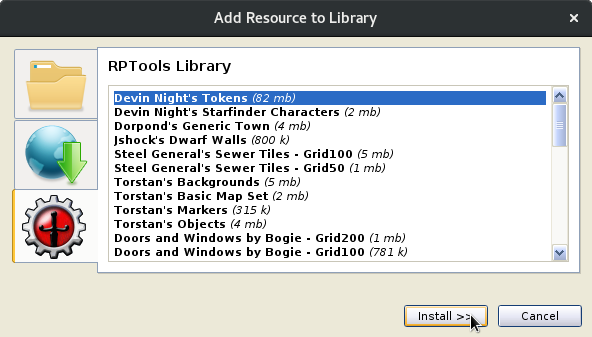
You can import avails you already have on your estimator past selecting files from the file system, using the same dialogue box.
MapTool resources appear in the Library console. If your MapTool window has no Library panel, select Library in the Window menu to add one.
Get together your maps
The next step in preparing for your game is to gather maps. Depending on what you're playing, that might mean you need to describe your maps, purchase a map pack, or just open up a map bundled with a game module. If all you need is a generic dungeon, yous can also download costless maps from inside MapTool'due south Add Resource to Library.
If you have a set of maps you intend to use ofttimes, you can import them equally resources. If you are building a entrada you lot intend to use just once, you tin can apace add any PNG or JPEG file every bit a New Map in the Map menu.

Set up the Background to a texture that roughly matches your map or to a neutral colour.
Set the Map to your map graphics file.
Give your new map a unique Proper name. The map name is visible to your players, and so keep it free of spoilers.
To switch between maps, click the Select Map button in the peak-right corner of the MapTool window, and choose the map proper name in the drop-down menu that appears.
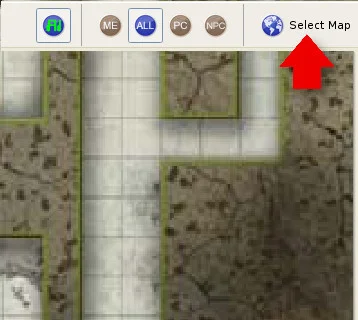
Before you lot let your players loose on your map, you lot withal take some important prep work to do.
Accommodate the grid size
Since nigh RPGs govern how far players tin motion during their turn, especially during combat, game maps are designed to a specific scale. The nearly common calibration is ane map square for every five feet. Well-nigh maps yous download already have a grid drawn on them; if you're designing a map, you should describe on graph paper to go on your scale consistent. Whether your map graphic has a grid or non, MapTool doesn't know nearly it, but you lot can adjust the digital grid overlay so that your player tokens are constrained into squares along the grid.
MapTool doesn't evidence the grid by default, so go to the Map menu and select Arrange grid. This displays MapTool's filigree lines, and your goal is to make MapTool's grid line up with the grid drawn onto your map graphic. If your map graphic doesn't have a grid, it may indicate its scale; a common scale is one inch per five feet, and y'all can usually assume 72 pixels is i inch (on a 72 DPI screen). While adjusting the grid, you lot can modify the color of the grid lines for your ain reference. Set the prison cell size in pixels. Click and elevate to align MapTool's grid to your map's grid.

If your map has no grid and yous desire the grid to remain visible after you adjust it, go to the View menu and select Testify Filigree.
Add together players and NPCs
To add a player grapheme (PC), not-player character (NPC), or monster to your map, notice an appropriate token in your Library panel, then drag and drop ane onto your map. In the New Token dialogue box that appears, requite the token a proper noun and set it as an NPC or a PC, then click the OK button.
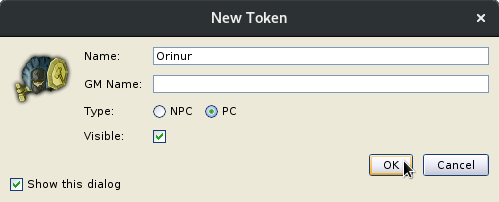
One time a token is on the map, try moving it to see how its movements are constrained to the grid you lot've designated. Make certain Interaction Tools, located in the toolbar just under the File card, is selected.
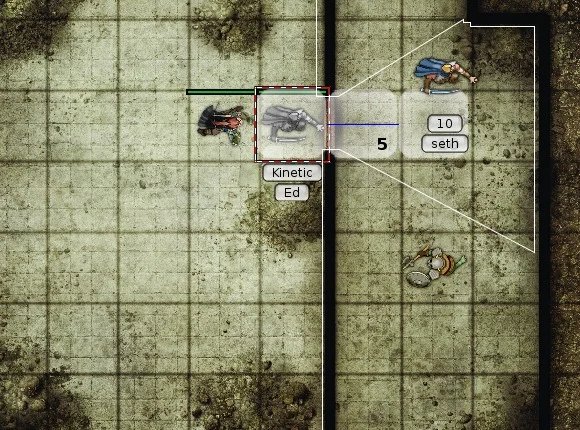
Each token added to a map has its own ready of properties, including the management it'south facing, a lite source, player ownership, atmospheric condition (such as incapacitated, prone, dead, and then on), and even course attributes. Yous can gear up equally many or every bit few of these as you desire, but at the very least y'all should correct-click on each token and assign it ownership. Your players must be logged into your MapTool server for tokens to exist assigned to them, but you lot can assign yourself NPCs and monsters in accelerate.
The correct-click carte du jour provides access to all important token-related functions, including setting which direction it's facing, setting a health bar and health value, a re-create and paste role (enabling you and your players to motion tokens from map to map), and much more than.
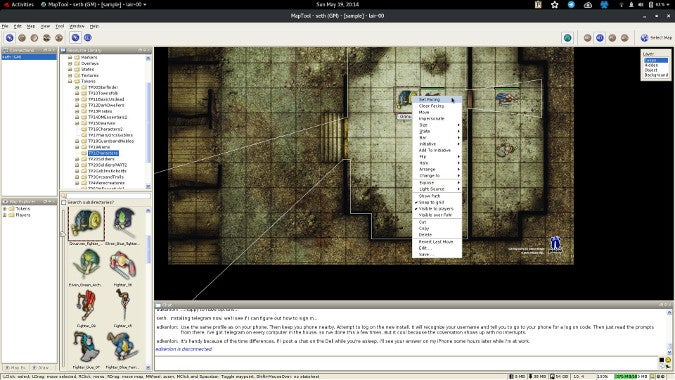
Activate fog-of-state of war furnishings
If yous're using maps exclusively to coordinate gainsay, y'all may not demand a fog-of-state of war consequence. But if you're using maps to aid your players visualize a dungeon they're exploring, you probably don't want them to run into the whole map before they've made significant moves, like opening locked doors or braving a decomposable bridge over a pit of hot lava.
The fog-of-state of war result is an invaluable tool for the GM, and it's essential to set it up early and so that your players don't accidentally get a sneak peek at all the horrors your dungeon holds for them.
To activate fog-of-war on a map, become to the Map and select Fog-of-War. This blackens the unabridged screen for your players, so your adjacent pace is to reveal some portion of the map and then that your players aren't faced with full darkness when they switch to the map. Fog-of-state of war is a subtractive process; it starts 100% dark, and as the players progress, you reveal new portions of the map using fog-of-war drawing tools bachelor in the FOG toolbar, merely nether the View carte.
You can reveal sections of the map in rectangle blocks, ovals, polygons, diamonds, and freehand shapes. Once you've selected the shape, click and release on the map, drag to define an area to reveal, and then click again.
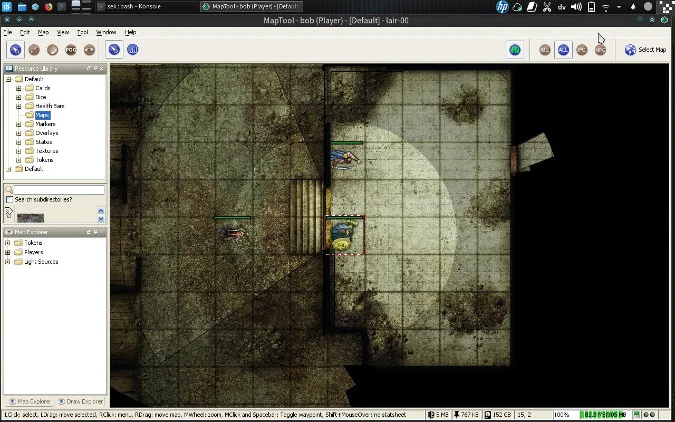
If yous're accidentally overzealous with what you lot reveal, yous accept two ways to reverse what yous've done: You tin manually draw new fog, or you can reset all fog. The quicker method is to reset all fog with Ctrl+Shift+A. The more elegant solution is to press Shift, then click and release, draw an expanse of fog, and and then click again. Instead of exposing an expanse of the map, information technology restores fog.
Add together lighting effects
Fog-of-state of war mimics the natural miracle of non being able to run across areas of the world other than where you are, merely lighting effects mimic the visibility player characters might feel in light and dark. For games like Pathfinder and Dungeons and Dragons 5e, visibility is governed by light sources matched against light conditions.
First, activate lighting past clicking on the Map menu, selecting Vision, and then choosing either Daylight or Nighttime. Now lighting furnishings are active, but none of your players take low-cal sources, and so they accept no visibility.
To assign calorie-free sources to players, right-click on the appropriate token and choose Light Source. Definitions exist for the D20 system (candle, lantern, torch, and and then on) and in generic measurements.
With lighting effects active, players can expose portions of fog-of-state of war as their light sources get closer to unexposed fog. That's a nifty consequence, merely it doesn't make much sense when players can illuminate the next room correct through a solid wall. To preclude that, you take to help MapTool differentiate betwixt empty space and solid objects.
Ascertain solid objects
Defining walls and other solid objects through which light should non pass is easier than it sounds. MapTool's Vision Blocking Layer (VBL) tools are bones and built to minimize prep time. There are several basic shapes available, including a basic rectangle and an oval. Draw these shapes over all the solid walls, doors, pillars, and other obstructions, and you have instant rudimentary physics.
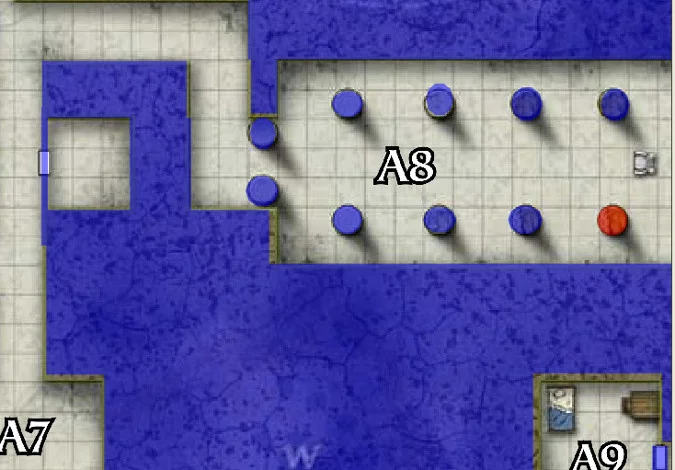
Now your players tin can motion around the map with light sources without seeing what lurks in the shadows of a nearby pillar or backside an innocent-looking door… until it'southward too tardily!
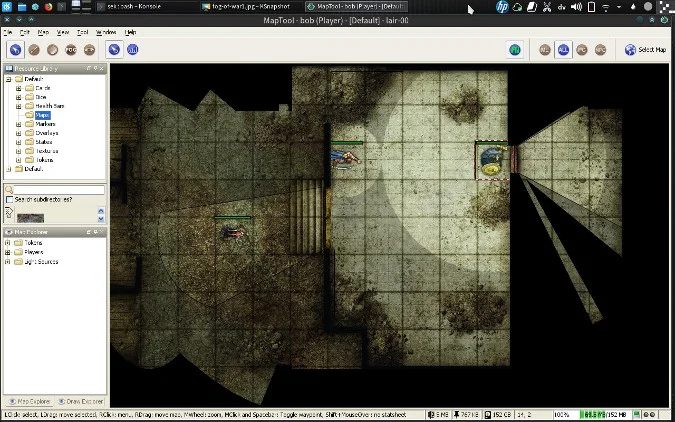
Rails initiative
Eventually, your players are going to stumble on something that wants to kill them, and that ways combat. In virtually RPG systems, combat is played in rounds, with the order of turns decided past an initiative roll. During combat, each player (in society of their initiative coil, from greatest to lowest) tries to defeat their foe, ideally dealing enough damage until their foe is left with no health points (HP). It'due south normally the most paperwork a GM has to do during a game because it involves tracking whose turn information technology is, how much damage each monster has taken, what amount of damage each monster'due south attack deals, what special abilities each monster has, and more. Luckily, MapTool tin can assist with that—and better yet, you tin extend it with a custom macro to do even more.
MapTool'south basic initiative panel helps you keep track of whose turn it is and how many rounds accept transpired and so far. To view the initiative panel, become to the Window card and select Initiative.
To add together characters to the initiative order, right-click a token and select Add To Initiative. As you add each, the token and its label appear in the initiative panel in the order that you add them. If you lot make a error or someone holds their action and changes the initiative society, click and drag the tokens in the initiative panel to reorder them.
During combat, click the Next button in the top-left of the initiative panel to progress to the side by side character. As long every bit you use the Next button, the Round counter increments, helping you track how many rounds the combat has lasted (which is helpful when you have spells or effects that last only for a specific number of rounds).
Tracking gainsay guild is helpful, just it'due south fifty-fifty better to track health points. Your players should exist tracking their own health, simply since everyone'south staring at the same screen, it doesn't hurt to runway information technology publicly in ane place. An HP holding and a graphical wellness bar (which y'all can actuate) are assigned to each token, and then that's all the infrastructure you lot need to track HP in MapTool, simply doing it manually takes a lot of clicking around. Since MapTool tin can exist extended with macros, information technology's trivial to bring all these components together for a polish GM experience.
The first footstep is to activate graphical health bars for your tokens. To do this, right-click on each token and select Edit. In the Edit Token dialog box, click on the State tab and deselect the radio button next to Hide.
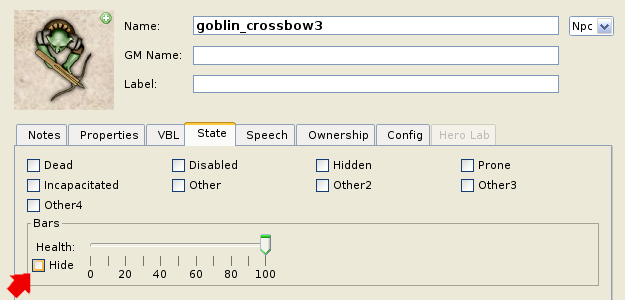
Do this for each token whose wellness you desire to expose.
Write a macro
Macros take access to all token backdrop, and so each token'southward HP tin be tracked by reading and writing whatever value exists in the token's HP property. The graphical health bar, still, bases its land on a percentage, then for the wellness bars to be meaningful, your tokens also must have some value that represents 100% of its HP.
Go to the Edit menu and select Campaign Properties to globally add properties to tokens. In the Campaign Properties window, select the Token Properties tab and and then click the Bones category in the left column. Under *@HP, add *@MaxHP and click the Update button. Click the OK button to close the window.

Now correct-click a token and select Edit. In the Edit Token window, select the State tab and enter a value for the token's maximum HP (from the thespian'south grapheme canvas).
To create a new macro, reveal the Entrada console in the Window carte.
In the Entrada panel, right-click and select Add New Macro. A push labeled New appears in the panel. Correct-click on the New button and select Edit.
Enter this lawmaking in the macro editor window:
[h:status = input(
"hpAmount|0|Points",
"hpType|Damage,Healing|Harm or heal?|RADIO|SELECT=0")]
[h:abort(status)][if(hpType == 0),Code: {
[h:HP = HP - hpAmount]
[h:bar.Health = HP / MaxHP]
[r:token.name] takes [r:hpAmount] damage.};
{
[h:diff = MaxHP - HP]
[h:HP = min(HP+hpAmount, MaxHP)]
[h:bar.Health = HP / MaxHP]
[r:token.name] gains [r:min(diff,hpAmount)] HP. };]
You can find total documentation of functions available in MapTool macros and their syntax from the RPTools wiki.
In the Details tab, enable Include Label and Apply to Selected Tokens, and go out all other values at their default. Give your macro a better name than New, such every bit HPTracker, then click Apply and OK.
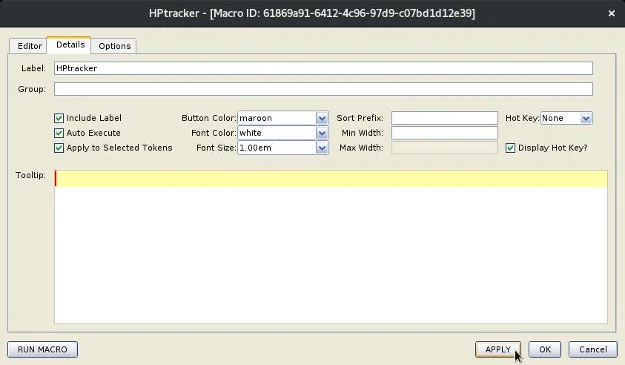
Your campaign now has a new ability!
Select a token and click your HPTracker button. Enter the number of points to deduct from the token, click OK, and watch the health bar modify to reflect the token's new state.
It may seem similar a unproblematic change, just in the estrus of battle, this is a GM'due south greatest weapon.
During the game
There's obviously a lot you can do with MapTool, but with a little prep work, most of your work is washed well earlier you start playing. You can even create a template entrada by creating an empty campaign with only the macros and settings you want, so all you lot have to do is import maps and stat out tokens.
During the game, your workflow is mostly about revealing areas from fog-of-war and managing combat. The players can manage their ain tokens, and your prep work takes intendance of everything else.
MapTool makes digital gaming easy and fun, and most importantly, it keeps it open up source and self-contained. Level-upward today past learning MapTool and using information technology for your games.
Source: https://opensource.com/article/19/6/how-use-maptools
0 Response to "Digital Map Upload With Fog of War"
Post a Comment